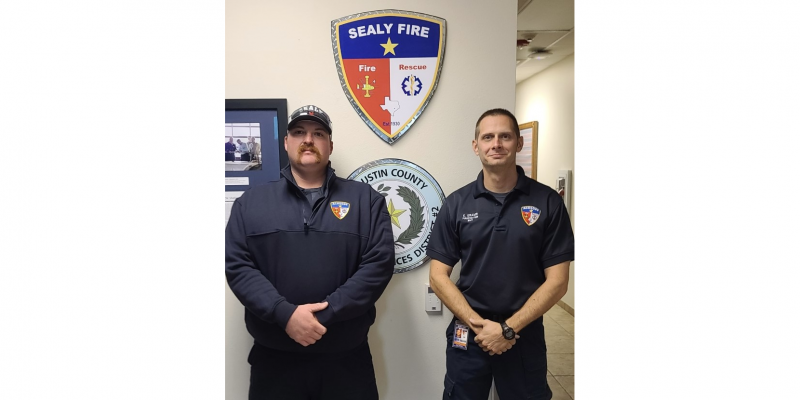Sealy Fire makes first full-time hires
Kramr, Kern to serve as ACESD No. 2/Sealy Fire’s first full-time firefighters
Austin County Emergency Service District No. 2/Sealy Fire Department made a historic move in the hiring of their first full-time firefighters. Jan 3, two members – Columbus’ Kevin Kramr and Bellville’s Devin Kern – became the first full-time firefighters in Sealy and Austin County.
Austin County ESD No. 2/Sealy Fire and its community are facing challenging times ahead with community growth and expectations. Since 2009, timely incremental changes have been made to address the needs of the growing response area and thanks to local support from the community, this moment is no different.
The department will remain a combination entity for the foreseeable future and our oath is fiscal and financial responsibility and transparency to those that we are charged with protecting including the men and women serving. Within the means provided, the local fire department will always strive to meet the community’s expectations in services or needs.
Devin Kern
Kern comes to Sealy from Bryan Fire Department where he worked full-time as a firefighter/paramedic. He attended the TEEX EMS Basic program in 2014 and later attended the TEEX Fire Academy Class 145 in the fall of the same year. Kern began his career in the fire service as a volunteer firefighter at Nazareth VFD in 2011. He and his wife Erica have two children, Colt (10 years old) and Cheyenne (12). Kern grew up in a firefighter family and has always known he would have a career in the fire service. He said he is happy to be part of ACESD No. 2.
Kevin Kramr
Kramr was born and raised in Fayetteville. After graduating high school in 2000, he joined the U.S. Air Force where he served four years. In that time, he did several tours in Kuwait and Oman in support of Operation Enduring Freedom and Iraqi Freedom. After returning to Fayetteville in 2004, Kramr obtained his EMT and started volunteering with the Fayetteville Volunteer Fire Department in 2005. He worked several years as an EMT for Fayette County EMS and soon after began working for LCRA. In 2015, Kramr obtained his TCFP Firefighter basic certification and joined ACESD No. 2. Before becoming a full-time employee at ACESD No. 2, he previously worked full-time as a Lieutenant for the Northwest Fire Department in Northwest Harris County. Kramr and his wife Tori have two children, Harper (8 years old) and Wyatt (12).
In 2009, as volunteer numbers dwindled and calls increased in the district, the department began hiring part-time professional firefighters to help staff a mostly volunteer organization. This created what is known as a combination department. Through the years, the numbers have changed and responsibilities continue to increase.
The staff features a few dedicated volunteers but mostly consists of 25 part-time professional firefighters. These personnel typically work for other fire departments full-time and use their days off to work part-time for Austin County ESD No. 2/ Sealy Fire Department. The department is currently minimally staffed 24/7 with four firefighters assigned to the apparatus daily and three to four nightly.
Fire departments in Austin County depend on mutual aid from each other now more than ever for major incidents such as residential fires, major automobile accidents or multiple emergencies occurring at the same time.
It is a sign of the times as dedicated available volunteers and/or paid professional personnel are increasingly harder to come by. People simply do not have time anymore. In addition, professional salaries are increasingly competitively from community to community all leading to shortages.
Today, a residential fire in our county routinely requires three or more departments to get the personnel numbers needed to operate safely, however it often takes precious minutes to arrive. So, as the demographic need changes, local first responders must continue to proactively adapt.
The best equipment in the world is no good without people, and the most recent steps taken are again incremental measures providing much-needed staffing.
Change is inevitable being that we are 50 miles from a large metropolitan city of millions. Mass migration will continue to stress our rural local resources as needs and expectations grow.



